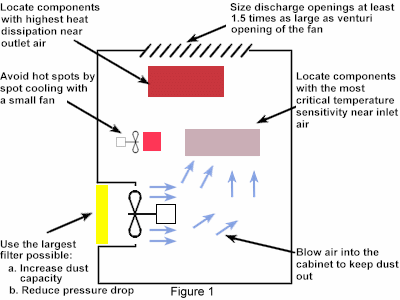FORCED CONVECTION COOLING
Of the many ways to dissipate heat in electronic components, forced convection cooling is the most effective. These application notes will discuss several areas of importance in determining the correct fan or blower for any specific application.
Once the decision is made to use forced convection cooling, several points must be considered before a fan can be specified. Forced convection heat transfer can be effected in two ways: evacuation or pressurization of the cabinet. When evacuating a cabinet (fan on the exhaust side), the air distribution inside the cabinet is flexible. Cooling ports can be placed at any position in the cabinet to insure proper cooling in desire locations. Heat from the fan itself is not dissipated into the cabinet. However, filtering the fan on the exhaust side is extremely difficult.
Pressurizing the cabinet is the preferred method, since incoming air can be readily filtered. With the cabinet under pressure, any cracks or crevices will have a small amount of leakage from the cabinet and dust will not seep in. The fan is handling cooler, denser air, and it will have a slightly higher pressure capability. Fan life and reliability are increased because the fan ambient temperature is lower. The disadvantage of pressurization is that heat generated by the fan is dissipated into the cabinet.
The voltage regulation option is designed for applications where the input power may fluctuate at different voltage levels. An example would be a backup generator, or outdoor telecommunications equipment that periodically undergoes battery regeneration. In these applications, a change in input voltage would result in a change in the fan’s rpm and thus, noise and power.
To avoid unwanted fluctuations, Comair Rotron fans can be equipped with an internal regulating circuit that maintains a constant voltage source to the fan windings; regardless of how the input voltage changes. This is accomplished by using a voltage regulator and clamping the adjust leg with a zener diode. See Figure 1. Everything is built into the fan. There are no extra components or extra wires to deal with in your system. The Comair solution is simple and easy.

Follow these basic 5 steps when designing for a cooling fan.
- Locate the fan to pressurize the enclosure assuring lowest fan operating temperature.
- If air flow is to be vertical through the equipment to be cooled, place fan at the bottom so that it works to aid natural convection.
- Place largest heat source toward air exit so that it will have maximum heating effect on air cooling low power areas of the system.
- If air filters and RFI screens are required in a given application, their air impedance must be considered in air mover selection.
- LAvoid as many obstructions in the packaging of the equipment at fan outlet and general air path since more resistance to flow means a larger, more power consuming air moving device. Leave a fan radius between obstructions and the fan inlet and exhaust.